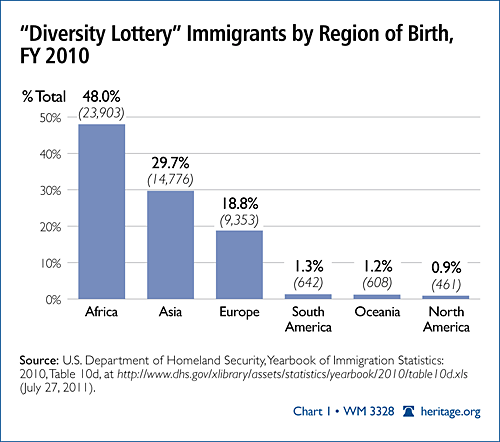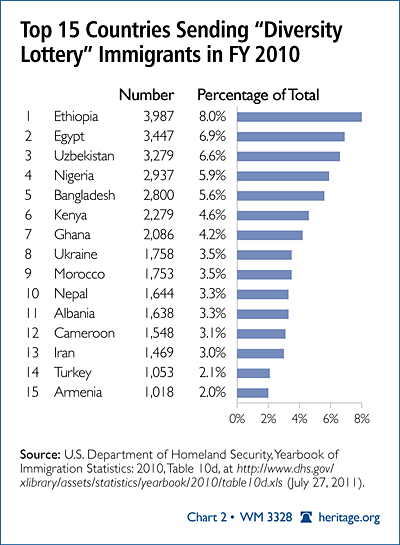The House Judiciary Committee recently approved H.R. 704, a bill that would abolish a provision of U.S. immigration law called the Diversity Immigrant Visa Program, or “diversity lottery” for short.[1] The diversity lottery has been an unwise policy since its inception in 1986. It does not bolster the skills of the American workforce, nor does it reunite families or serve any humanitarian function. Its only purpose is to increase ethnic and cultural heterogeneity in the U.S.—a dubious goal that weakens the social ties within communities. Ending the diversity lottery would be a welcome reform.
How the Diversity Lottery Works
The Diversity Immigrant Visa Program is a lottery that randomly distributes green cards (permanent legal residency) to up to 55,000 applicants worldwide each year. True to its name, the diversity lottery is not open to residents of countries that already send thousands of immigrants each year through other categories of admission. Canadians, Mexicans, Brazilians, and Poles, for example, are not eligible. Countries not automatically excluded are given visas in proportion to their region’s immigration rarity—the fewer regular immigrants a region sends, the more diversity visas it receives. Aside from living in an eligible country, the only requirement for lottery applicants is a high school degree or two years working at a job that requires two years of training to hold.
Strictly speaking, the lottery increases the diversity of recent immigrants—not necessarily the diversity of the U.S. as a whole. In fact, one of the original proponents of the lottery was former Senator Edward Kennedy (D–MA), who was concerned that immigration from Ireland had become too low. If the lottery mainly facilitated immigration from Ireland and other European countries that once sent many immigrants to the U.S. but now send relatively few, then the “diversity” lottery would actually bolster America’s white majority.
In practice, however, the lottery grants green cards to large portions of the world that have no history of immigration to the U.S., thus increasing the ethnic and cultural heterogeneity of the nation. Chart 1 indicates that more than three-quarters of lottery winners obtaining green cards in fiscal year 2010 were born in Africa or Asia, compared to fewer than one in five from Europe. Chart 2, which lists the top 15 countries sending lottery winners, reveals that countries in sub-Saharan Africa, North Africa, and South Asia are most commonly represented.


Fraud and Abuse
Like many government programs that dispense valuable items—a green card, in this case—the diversity lottery is subject to fraud and abuse. In a 2007 report, the Government Accountability Office (GAO) found “pervasive fraud” in applications to the program, including the use of fake birth certificates and passports to support multiple entries for a single person. The GAO also expressed concern that the program’s identity verification is not adequate to prevent people who pose a security risk from entering the country through the lottery.[2]
The Negative Effects of Diversity
Even if fraud were not an issue, the diversity lottery is not a rational policy. It does not select for the kinds of immigrant characteristics that most Americans consider desirable. Its only essential selection criterion—diversity—is of questionable value.
The three main kinds of legal immigrants the U.S. currently accepts are people with family members already in the U.S. (66 percent of immigrants in 2010), workers with desirable skills (14 percent), and refugees (13 percent).[3] A better mix of selection factors would give more emphasis to skill-based immigration, but the diversity lottery involves no selection at all. It does not make the workforce more skilled, reunite families, or further any humanitarian goals. Its exclusive purpose is to increase the diversity of immigrants’ national origins.
Is diversity a compelling national interest? Academic evidence suggests that it is not. Diversity tends to weaken the social ties that bind neighborhoods and towns together. Holding other factors constant, people living in more diverse communities will, on average:
• trust their neighbors less,
• maintain fewer friendships,
• participate less in community groups,
• give less to charity, and
• report lower levels of happiness.[4]
Because homogeneous communities generally function better than heterogeneous ones, the U.S. should not seek immigrant diversity simply for the sake of diversity. If introducing greater immigrant diversity is necessary, it should occur only after a careful analysis of its costs and benefits in conjunction with other immigration goals. A random and haphazard approach to diversity is certainly not in the national interest.
Purposeful Immigration Policy
The Diversity Immigrant Visa Program is a random lottery that gives out visas to immigrants from exotic countries. In addition to its susceptibility to fraud, the program is not based on a rational assessment of American interests. The U.S. should be carefully selecting immigrants who will contribute to the economy and blend into the common culture. The diversity lottery works against those goals by promoting diversity and little else. Far from being a primary good, diversity has been shown to weaken communities. Ending the diversity lottery would be a firm step toward a more careful and considered legal immigration policy.
Jason Richwine, Ph.D., is Senior Policy Analyst in the Center for Data Analysis at The Heritage Foundation.



